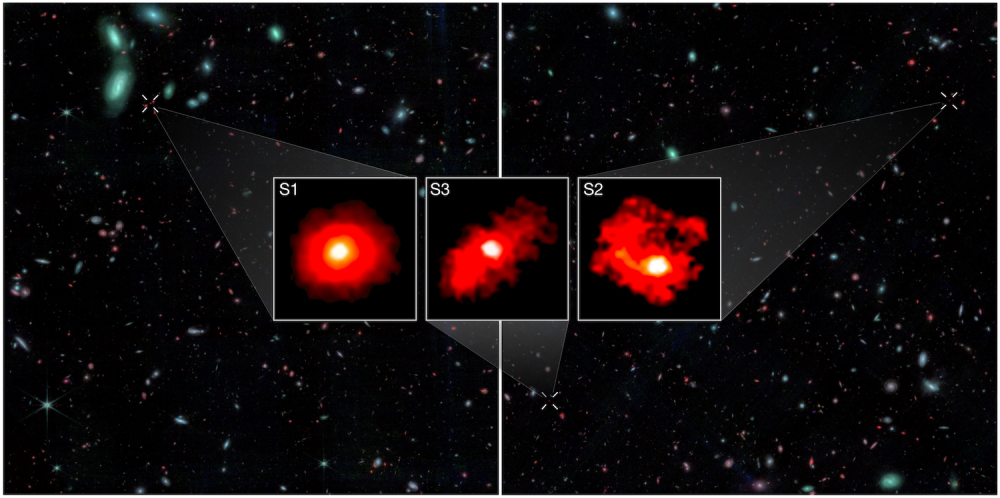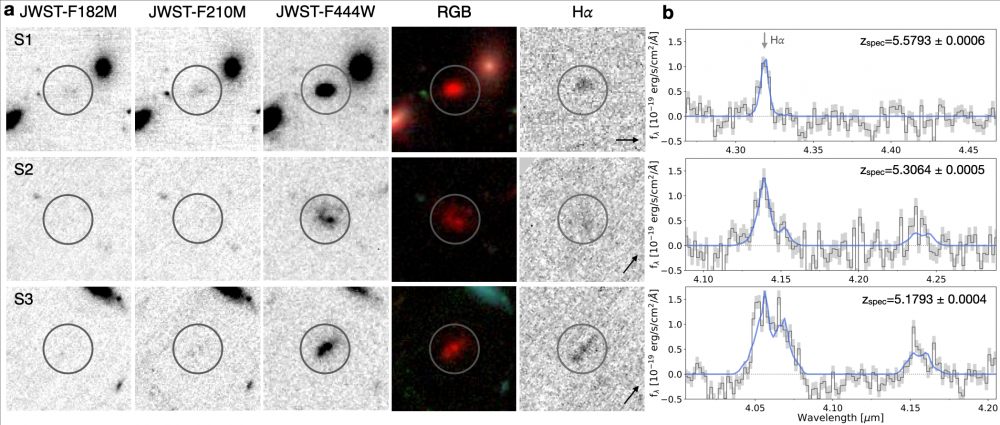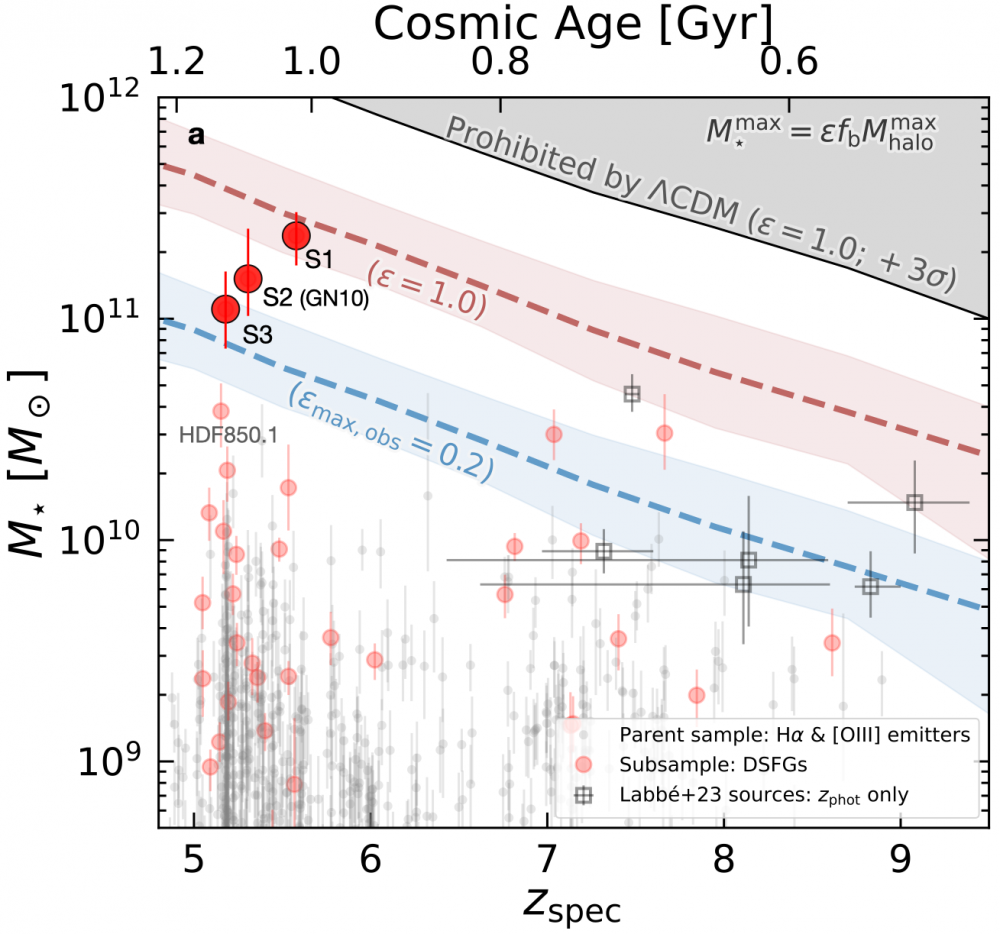
Figure 1: Images of three massive, distant galaxies that challenge our understanding of galaxy formation. Credits: NASA/CSA/ESA, M. Xiao & P. A. Oesch (University of Geneva), G. Brammer (Niels Bohr Institute), Dawn JWST Archive
Is the Standard Model of cosmology, the basis of our understanding of the Universe since the Big Bang, in danger? Recent observations by the James Webb Space Telescope (JWST), carried out by an international team including the CEA-IRFU Astrophysics Department, have revealed massive galaxies in the young Universe, sparking a lively debate within the scientific community. While some researchers see this as calling the model into question, others argue that these galactic masses have been overestimated, suggesting that more precise measurements could resolve the enigma without invalidating the Standard Model. Thanks to the FRESCO programme, spectroscopic data that are more precise than previous measurements appear to reconcile these early galaxies with theoretical predictions. However, three extreme cases continue to challenge our understanding of galaxy formation.
The Standard Model of Cosmology called into question
The Standard Model of Cosmology (also known as the ΛCDM model - Lambda Cold Dark Matter model) is the model currently favoured by scientists to describe the evolution of the Universe since the Big Bang. In particular, it is used to explain astronomers' observations such as the cosmic microwave background - radiation coming from all directions in the sky - large-scale structures and the formation of galaxies in clusters.
So when astronomers took their first look at the young Universe with NASA's James Webb Space Telescope (JWST), they expected to find rather modest and growing galaxies, in line with the predictions of this standard model. Instead, the scientists discovered an unexpected abundance of galaxies that were too massive for the young age of the Universe.
Since then, two communities of scientists have been at loggerheads: on the one hand, those who believe that these discoveries highlight gaps in the Standard Model of cosmology and call for it to be completely called into question; on the other, those who dispute the measurements of galactic masses, which are said to be overestimated because they are based solely on photometric observations that are not sufficiently precise. This would mean that models of galactic growth would have to be revised, without however calling the Standard Model into question.

Figure 2: Images and spectra of the three ultra-massive and primitive galaxies (Z ? 5 - 6) observed by the FRESCO observing programme using the NIRCam instrument on the JWST. The images on the left were taken with 3 NIRCam filters (1.82µm, 2.10µm and 4.44µm), then combined in colour (F182M in blue, F210M in green and F444W in red), accompanied by the map in H?. And on the right, the 1D spectra (covering the H?, [NII] and [SII] emission lines) obtained with the NIRCam grism and the F444W filter. The grey areas show the uncertainty associated with 1 sigma, and the blue line represents the model that best fits the data. Credits: Xiao et al. 2024
The FRESCO observation programme provides new answers
It is in this context that an international team, including astronomers from the Astrophysics Department at CEA Paris-Saclay, is providing new explanations thanks to the FRESCO observation programme. The aim of this programme is to accurately measure the mass of the first galaxies using the NIRCam/grism instrument on the JWST, which allows high-resolution spectroscopic measurements that are much more precise than the photometric measurements carried out previously (see Figure 2).
"NIRCam allows us to identify and study the growth of galaxies over time, and to obtain a clearer picture of how stellar mass accumulates over the course of cosmic history," explains Pascal Oesch, assistant professor in the Department of Astronomy at the UNIGE, principal investigator in this observation programme and co-author of this new study.
"Only the James Webb has the capacity to measure the mass of stars in galaxies at such a long time ago, a billion years after the big bang, because the light is shifted into the infrared," explains David Elbaz, scientific director of the Astrophysics Department at CEA Paris-Saclay and co-author of the article.
A challenge to the cosmological standard model ruled out
Using data from the FRESCO programme, the team of researchers was able to carry out a systematic study of 36 massive galaxies. The analysis suggests that most of the ultra-massive galaxies in the early Universe are compatible with the Standard Cosmological Model, except for three that represent a potential challenge, calling into question models of galactic formation (see Figure 3).
"These galaxies have star formation rates close to 1,000 solar masses per year, rates that can only be explained by a very efficient formation process that current models cannot reproduce," says Dr Mengyuan Xiao, a post-doctoral researcher in the UNIGE's Department of Astronomy and first author of the study.
The challenge to the Standard Cosmological Model therefore seems to be receding. The new, more precise observations of galactic masses are making it possible to reconcile the observations with the predictions of the Standard Model. However, the existence of these three ultra-massive galaxies so early in the history of the Universe challenges our understanding of galaxy formation in the early Universe.
"These results suggest that some of the first galaxies were capable of converting gas into stars extremely efficiently, far beyond what is predicted by current models. Future observations with JWST and the Atacama Large Millimeter Array (ALMA) will be essential to determine whether these ultra-massive galaxies represent an extreme case or a more widespread phenomenon", concludes the researcher.
"We now need to understand how the universe formed galaxies more massive than the Milky Way nearly 13 billion years ago, around one billion years after the big bang", explains David Elbaz.

Figure 3: Comparison of the masses of massive and distant galaxies as a function of their redshift (Z) measured by photometry and spectroscopy, against the theoretical expectations given by the Standard Model of Cosmology (?CDM). The grey circles represent the galaxies reported in the literature, including those with the redshift (Z) measured solely by photometry (empty grey squares). The empty red circles correspond to the 36 galaxies observed with the FRESCO programme, whose redshifts have been precisely measured by spectroscopy using the JWST. The error bars show the measurement uncertainties. The red and blue lines show the maximum mass of galaxies expected from the ?CDM model, as a function of the conversion efficiency of baryons into stars (Epsilon = 1 and 0.2 respectively); the black line is the upper limit of the model. The solid red circles are the three galaxies that put our galactic formation theories to the test because, even though they remain compatible with the ?CDM model, these ultra-massives show an average star formation efficiency of Epsilon ? 0.5, indicating a very efficient conversion of baryons into stars that is difficult to explain today. Credits: Xiao et al. 2024
• Thèmes de recherche du Service d'astrophysique › Interpretation Structure et évolution de l'Univers
• Department of Astrophysics (DAp) // UMR AIM
• Cosmology and Galaxy Evolution
• JWST



